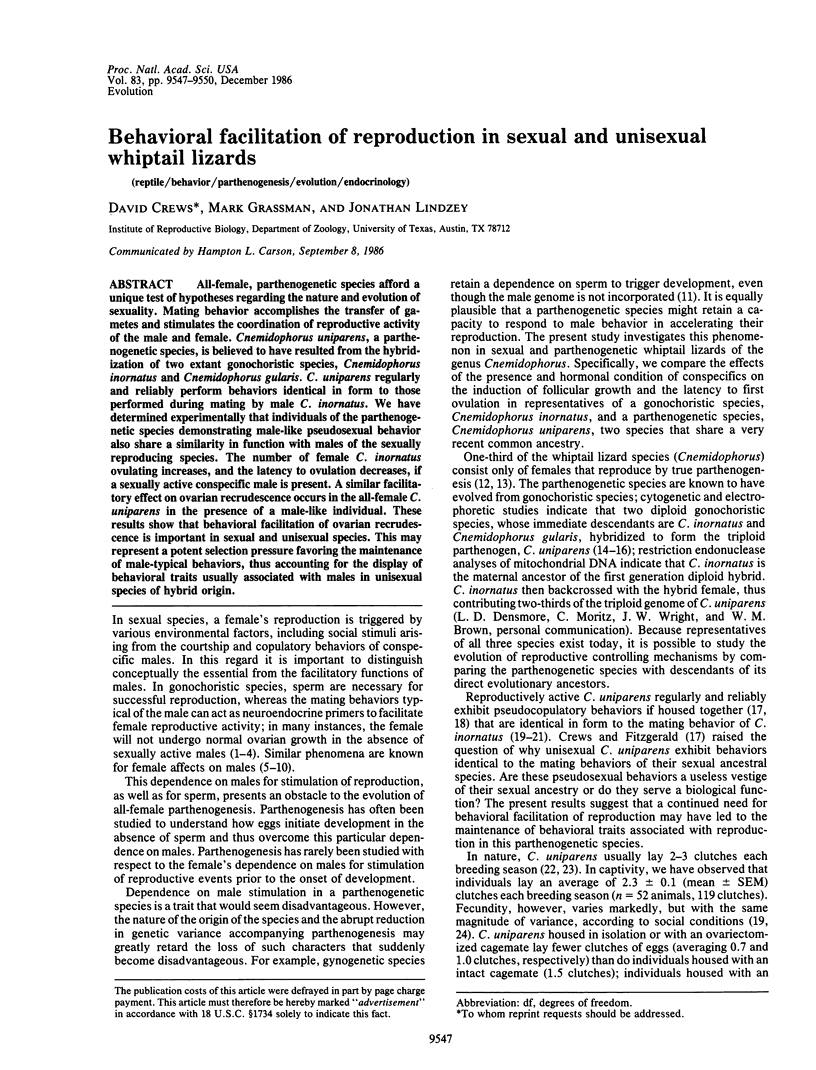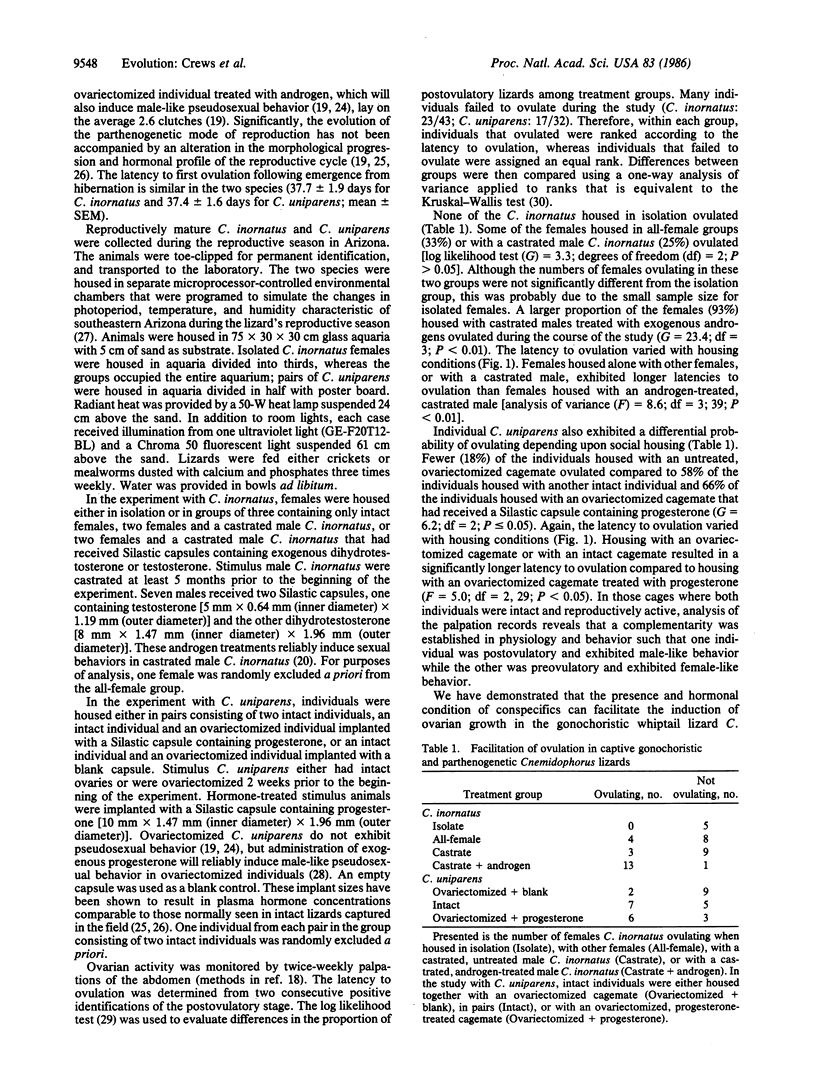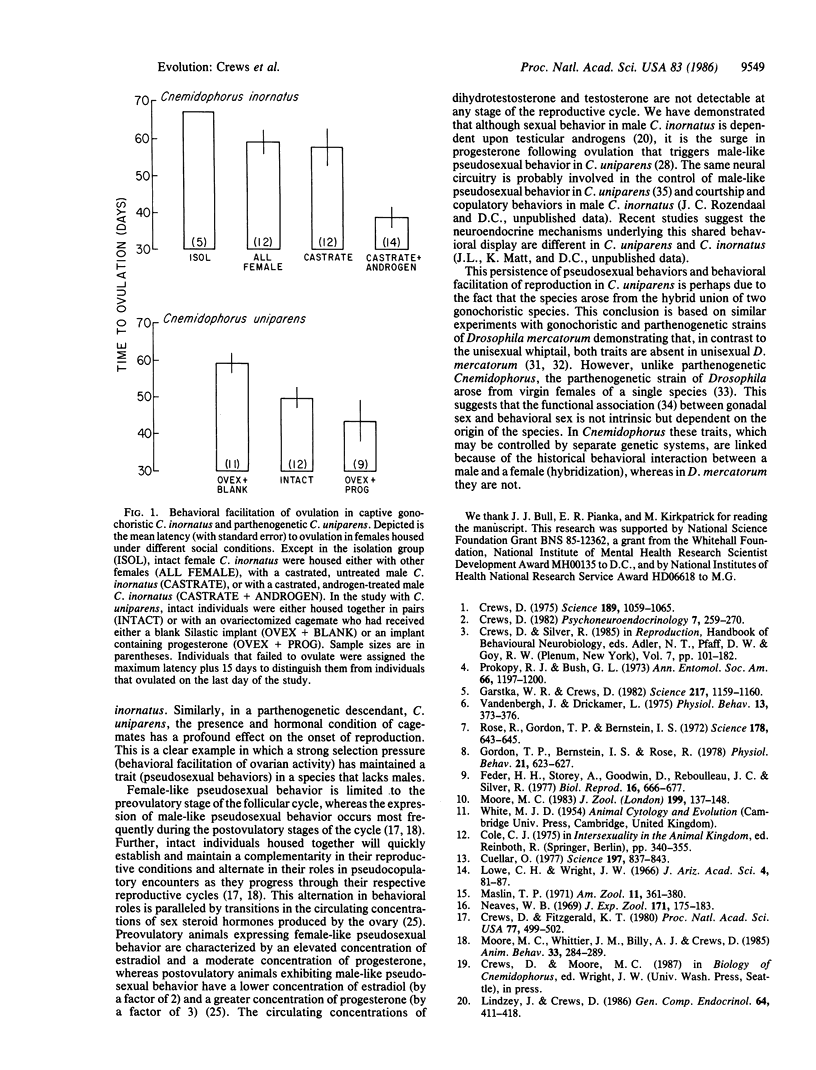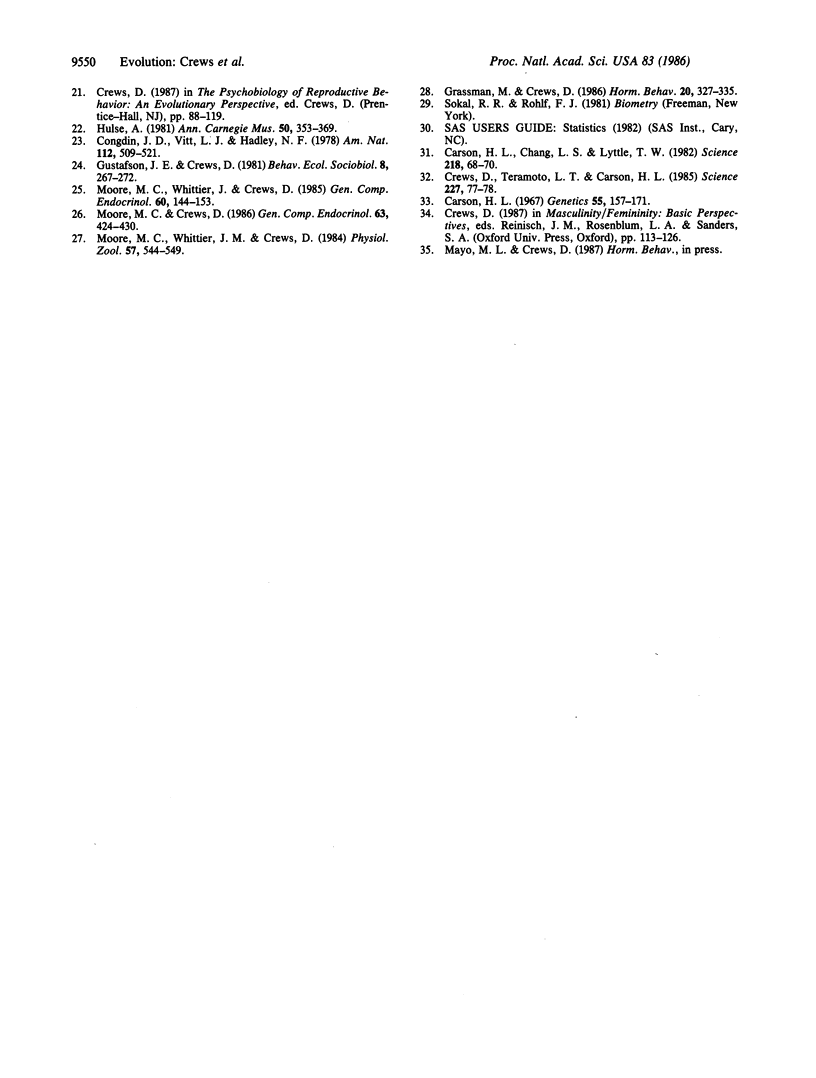Abstract
All-female, parthenogenetic species afford a unique test of hypotheses regarding the nature and evolution of sexuality. Mating behavior accomplishes the transfer of gametes and stimulates the coordination of reproductive activity of the male and female. Cnemidophorus uniparens, a parthenogenetic species, is believed to have resulted from the hybridization of two extant gonochoristic species, Cnemidophorus inornatus and Cnemidophorus gularis. C. uniparens regularly and reliably perform behaviors identical in form to those performed during mating by male C. inornatus. We have determined experimentally that individuals of the parthenogenetic species demonstrating male-like pseudosexual behavior also share a similarity in function with males of the sexually reproducing species. The number of female C. inornatus ovulating increases, and the latency to ovulation decreases, if a sexually active conspecific male is present. A similar facilitatory effect on ovarian recrudescence occurs in the all-female C. uniparens in the presence of a male-like individual. These results show that behavioral facilitation of ovarian recrudescence is important in sexual and unisexual species. This may represent a potent selection pressure favoring the maintenance of male-typical behaviors, thus accounting for the display of behavioral traits usually associated with males in unisexual species of hybrid origin.
Full text
PDF



Selected References
These references are in PubMed. This may not be the complete list of references from this article.
- Carson H. L., Chang L. S., Lyttle T. W. Decay of female sexual behavior under parthenogenesis. Science. 1982 Oct 1;218(4567):68–70. doi: 10.1126/science.218.4567.68. [DOI] [PubMed] [Google Scholar]
- Carson H. L. Selection for parthenogenesis in Drosophila mercatorum. Genetics. 1967 Jan;55(1):157–171. doi: 10.1093/genetics/55.1.157. [DOI] [PMC free article] [PubMed] [Google Scholar]
- Crews D., Fitzgerald K. T. "Sexual" behavior in parthenogenetic lizards (Cnemidophorus). Proc Natl Acad Sci U S A. 1980 Jan;77(1):499–502. doi: 10.1073/pnas.77.1.499. [DOI] [PMC free article] [PubMed] [Google Scholar]
- Crews D. On the origin of sexual behavior. Psychoneuroendocrinology. 1982;7(4):259–270. doi: 10.1016/0306-4530(82)90030-0. [DOI] [PubMed] [Google Scholar]
- Crews D. Psychobiology of reptilian reproduction. Science. 1975 Sep 26;189(4208):1059–1065. doi: 10.1126/science.1172294. [DOI] [PubMed] [Google Scholar]
- Crews D., Teramoto L. T., Carson H. L. Behavioral facilitation of reproduction in sexual and parthenogenetic Drosophila. Science. 1985 Jan 4;227(4682):77–78. doi: 10.1126/science.3964961. [DOI] [PubMed] [Google Scholar]
- Cuellar O. Animal parthenogenesis. Science. 1977 Aug 26;197(4306):837–843. doi: 10.1126/science.887925. [DOI] [PubMed] [Google Scholar]
- Feder H. H., Storey A., Goodwin D., Reboulleau C., Silver R. Testosterone and "5alpha-dihydrotestosterone" levels in peripheral plasma of male and female ring doves (Streptopelia risoria) during and reproductive cycle. Biol Reprod. 1977 Jun;16(5):666–677. doi: 10.1095/biolreprod16.5.666. [DOI] [PubMed] [Google Scholar]
- Garstka W. R. Female control of male reproductive function in a Mexican Snake. Science. 1982 Sep 17;217(4565):1159–1160. doi: 10.1126/science.7202252. [DOI] [PubMed] [Google Scholar]
- Gordon T. P., Bernstein I. S., Rose R. M. Social and seasonal influences on testosterone secretion in the male rhesus monkey. Physiol Behav. 1978 Oct;21(4):623–627. doi: 10.1016/0031-9384(78)90140-3. [DOI] [PubMed] [Google Scholar]
- Grassman M., Crews D. Progesterone induction of pseudocopulatory behavior and stimulus-response complementarity in an all-female lizard species. Horm Behav. 1986 Sep;20(3):327–335. doi: 10.1016/0018-506x(86)90041-3. [DOI] [PubMed] [Google Scholar]
- Lindzey J., Crews D. Hormonal control of courtship and copulatory behavior in male Cnemidophorus inornatus, a direct sexual ancestor of a unisexual, parthenogenetic lizard. Gen Comp Endocrinol. 1986 Dec;64(3):411–418. doi: 10.1016/0016-6480(86)90077-8. [DOI] [PubMed] [Google Scholar]
- Moore M. C., Crews D. Sex steroid hormones in natural populations of a sexual whiptail lizard Cnemidophorus inornatus, a direct evolutionary ancestor of a unisexual parthenogen. Gen Comp Endocrinol. 1986 Sep;63(3):424–430. doi: 10.1016/0016-6480(86)90142-5. [DOI] [PubMed] [Google Scholar]
- Moore M. C., Whittier J. M., Crews D. Sex steroid hormones during the ovarian cycle of an all-female, parthenogenetic lizard and their correlation with pseudosexual behavior. Gen Comp Endocrinol. 1985 Nov;60(2):144–153. doi: 10.1016/0016-6480(85)90308-9. [DOI] [PubMed] [Google Scholar]
- Neaves W. B. Adenosine deaminase phenotypes among sexual and parthenogenetic lizards in the genus Cnemidophorus (Teiidae). J Exp Zool. 1969 Jun;171(2):175–183. doi: 10.1002/jez.1401710205. [DOI] [PubMed] [Google Scholar]
- Rose R. M., Gordon T. P., Bernstein I. S. Plasma testosterone levels in the male rhesus: influences of sexual and social stimuli. Science. 1972 Nov 10;178(4061):643–645. doi: 10.1126/science.178.4061.643. [DOI] [PubMed] [Google Scholar]
- Vandenbergh J. G., Drickamer L. C. Reproductive coordination among free-ranging rhesus monkeys. Physiol Behav. 1974 Sep;13(3):373–376. doi: 10.1016/0031-9384(74)90090-0. [DOI] [PubMed] [Google Scholar]


